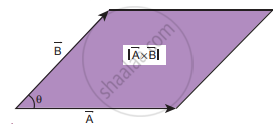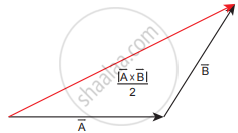Advertisements
Advertisements
प्रश्न
Discuss the properties of scalar and vector products.
उत्तर
Properties of the scalar product of two vectors are:
(1) The product quantity `vecA` . `vecB` is always a scalar. It is positive if the angle between the vectors is acute (i.e., < 90°) and negative if the angle between them is obtuse (i.e. 90°< 0 < 180°).
(2) The scalar product is commutative, i.e. `vecA vecB ± vecB . vecA`
(3) The vectors obey distributive law i.e. `vecA(vecB + vecC) = vecA . vecB + vecA . vecC`
(4) The angle between the vectors θ = `cos^-1[(vecA.vecB)/(AB)]`
(5) The scalar product of two vectors will be maximum when cos θ = 1, i.e. θ = 0°, i.e., when the vectors are parallel;
`(vecA . vecB)_"max" = AB`
(6) The scalar product of two vectors will be minimum, when cos θ = -1, i.e. θ = 180°.
`(vecA . vecB)_"min" = -AB` when the vectors are anti-parallel.
(7) If two vectors `vecA` and `vecB` are perpendicular to each other then their scalar product `vecA` . `vecB` = 0, because cos 90° 0. Then the vectors `vecA` and `vecB` are said to be mutually orthogonal.
(8) The scalar product of a vector with itself is termed as self-dot product and is given by `(vecA)^2 = vecA . vecA = A A cos 0 = A^2`. Here angle 0 = 0°.
The magnitude or norm of vector `vecA` is `|vecA| = A = sqrt(vecA . vecA.)`
(9) In case of a unit vector `hatn`
`hatn . hatn` = 1 × 1 × cos 0 = 1. For example, `hati - hatj = hatj . hatj = hatk . hatk = 1.`
(10) In the case of orthogonal unit vectors, `hati, hatj` and `hatk`, `hati . hatj = hatj . hatk = hatk . hat i = 1.1` cos 90° = 0
(11) In terms of components the scalar product of `vecA` and `vecB` can be written as `vecA . vecB = (A_xhati + A_yhatj + A_zhatk) . (B_xhati + B_yhatj + B_Zhatk)`
= AxBx + AyBy+ AzBz, with all other terms zero.
The magnitude of vector `|vecA|` is given by
`|vecA| = A = sqrt(A_x^2 + A_y^2 + A_z^2)`
Properties of the vector product of two vectors are:
(1) The vector product of any two vectors is always another vector whose direction is perpendicular to the plane containing these two vectors, i.e., orthogonal to both the vectors `vecA` and `vecB`, even though the vectors `vecA` and `vecB` may or may not be mutually orthogonal.
(2) The vector product of two vectors is not commutative, i.e., `vecA xx vecB ≠ vecB xx vecA`. But,`vecA xx vecB = -vecB xx vecA.`
Here it is worthwhile to note that `|vecA xx vecB| = |vecB xx vecA|` = AB sin 0 i.e., in the case of the product vectors `vecB = -vecB "and" vecB xx vecA,` the magnitudes are equal but directions are opposite to each other.
(3) The vector product of two vectors will have maximum magnitude when sin 0 = 1, i.e., 0 = 90° i.e. when the vectors `vecA` and `vecB` are orthogonal to each other.
`(vecA xx vecB)_"maz" = AB hatn = AB hatn`
(4) The vector product of two non-zero vectors will be minimum when sin θ = 0, i.e θ = 0° or 180° `(vecA xx vecB)_"min" = 0`
i. e., the vector product of two non – zero vectors vanishes, if the vectors are either parallel or anti-parallel.
(5) The self–cross product, i.e., a product of a vector with itself is the null vector `vecA xx vecA` = AA sin 0° `hatn` = `vec0` In physics, the null vector 0 is simply denoted as zero.
(6) The self–vector products of unit vectors are thus zero. `hati xx hati = hatj xx hatj = hatk xx hatk = 0`
(7) In the case of orthogonal unit vectors, `hati, hatj, hatk,` in accordance with the right-hand screw rule:
`hati xx hatj = hatk, hatj xx hatk = hati "and" hatk xx hati = hatj`

Also, since the cross product is not commutative, `hatj xx hati = -hatk. hatk xx hatj = -hati` and `hati xx hatk = hatj`
(8) In terms of components, the vector product of two vectors `vecA` and `vecB` is -
`vecA xx vecB = |(hati hatj hat k), (A_x A_y A_z), (B_x B_y B_z)|`
= `hati(A_yB_z - A_zB_y) + hatj(A_zB_x - A_xB_z) + hatk(A_xB_y - A_yB_x)`
Note that in the `hatj^"th"` component the order of multiplication is different than `hati^"th"` and `hatk^"th"` components.
(9) If two vectors `vecA` and `vecB` form adjacent sides in a parallelogram, then the magnitude of `|vecA xx vecB|` will give the area of the parallelogram as represented graphically in figure.
`|vecA xx vecB| = |vecA| |vecB| sintheta`

Area of parallelogram
(10) Since we can divide a parallelogram into two equal triangles as shown in the figure, the area of a triangle with `vecA` and `vecB` as sides is `1/2 |vecA xx vecB|`. This is shown in the Figure. A number of quantities used in Physics are defined through vector products. Particularly physical quantities representing rotational effects like torque, angular momentum, are defined through vector products.

Area of triangle
APPEARS IN
संबंधित प्रश्न
Two objects of masses m1 and m2 fall from the heights h1 and h2 respectively. The ratio of the magnitude of their momenta when they hit the ground is ______
Define a vector. Give examples?
Write a short note on the vector product between two vectors.
Explain in detail the triangle law of addition.
Convert the vector `vecr = 3hati + 2hatj` into a unit vector.
What are the resultants of the vector product of two given vectors given by `vecA = 4hati - 2hatj + hatk` and `vecB = 5hati + 3hatj - 4hatk`?
Calculate the area of the triangle for which two of its sides are given by the vectors `vecA = 5hati - 3hatj, vecB = 4hati + 6hatj`
The resultant of two vectors A and B is perpendicular to vector A and its magnitude is equal to half of the magnitude of vector B. Then the angle between A and B is
